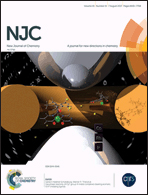Electrochemical deposition of Pt on carbon fiber cloth utilizing Pt mesh counter electrode during hydrogen evolution reaction for electrocatalytic hydrogenation reduction of p-nitrophenol†
Abstract
Through the slight dissolution of a Pt mesh counter electrode, Pt-deposited carbon fiber cloth (Pt/CFC) was successfully fabricated by successive cyclic voltammetry (CV) scanning from −0.77 V to 0.20 V (vs. RHE) in 0.5 M H2SO4 electrolyte. In the process of successive CV scanning, the electrocatalytic activity of CFC toward the hydrogen evolution reaction (HER) becomes better and better owing to Pt deposition on CFC, and after 1000 CV cycles, the onset potential of CFC is identical to that of the commercial Pt/C catalyst (0 V, vs. RHE) with high current densities at low overpotentials (η10, η100, and η170 = 4.5, 34.5, and 43.5 mV at current densities of 10, 100 and 170 mA cm−2). Interestingly, it was found that as-prepared Pt/CFC exhibits decreased HER activity with an onset potential of −0.26 V (vs. RHE) when Pt mesh was changed to bare CFC as the counter electrode, mainly due to the lower Pt loading amount (0.5 mg cm−2) on CFC compared to commercial Pt/C (Pt loading amount of 1.0 mg cm−2) and the inert CFC counter electrode (not like the Pt mesh counter electrode with slight dissolution in acidic media during CV scanning). Generally, there is great competition between the HER from water splitting and hydrogenation reduction of organic matter using the same HER-active electrocatalyst under identical experimental conditions. In this work, Pt/CFC was, therefore, evaluated for hydrogenation reduction of p-nitrophenol (PNP) to p-aminophenol (PAP) using water as the hydrogen donor in a CFC counter electrode configurated two-compartment reaction system. The results demonstrate that PNP can be effectively converted into PAP with a conversion efficiency of 83.1% and a Faradaic efficiency of 9.9% after electrocatalytic reaction for 12 h at an overpotential of −0.023 V. The findings of this work indicate that Pt counter electrodes are prone to dissolving, resulting in Pt deposition on the working electrode in acidic media, readily causing the false appearance of a non-Pt working electrode with high HER activity. Additionally, the Pt-deposited working electrode produced by this electrochemical approach is efficient for hydrogenation reduction of organic substances into high value-added chemicals using water as the hydrogenation donor.



 Please wait while we load your content...
Please wait while we load your content...